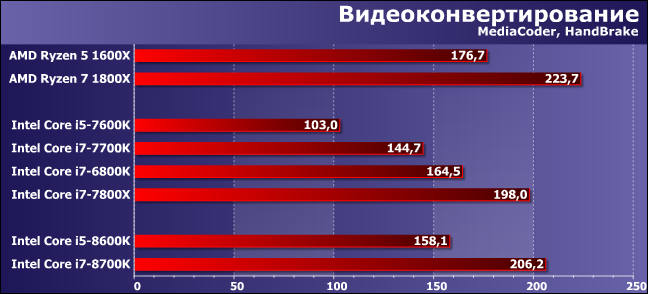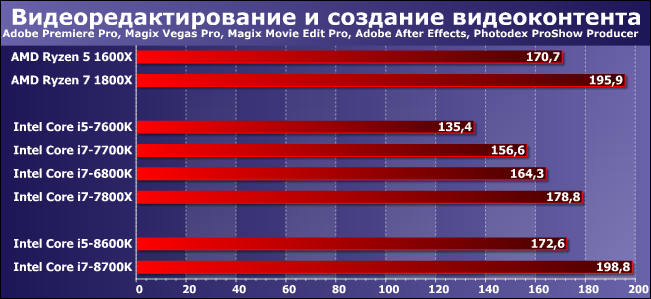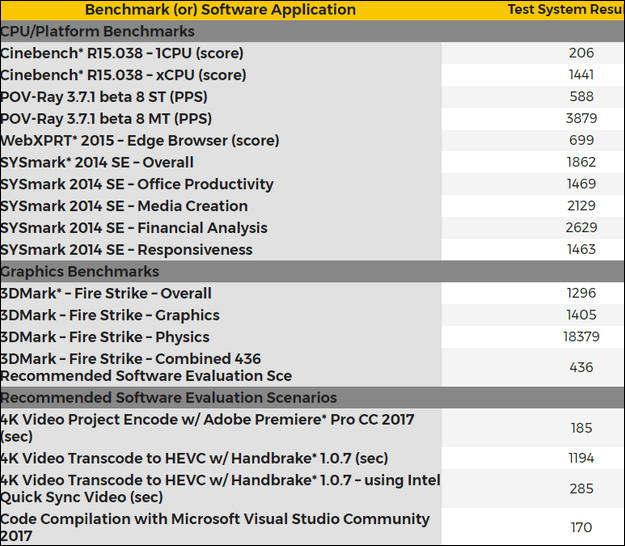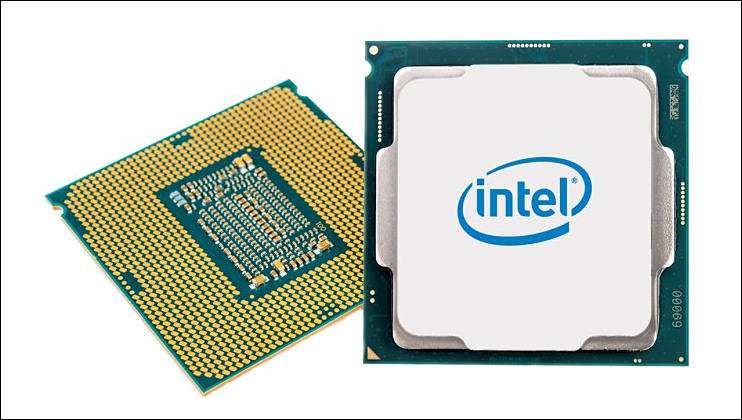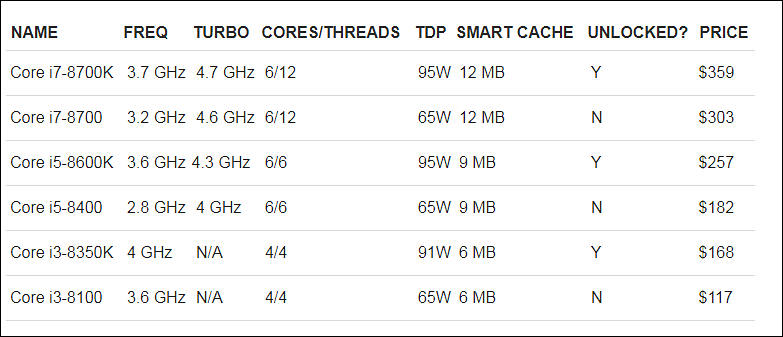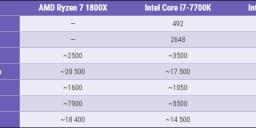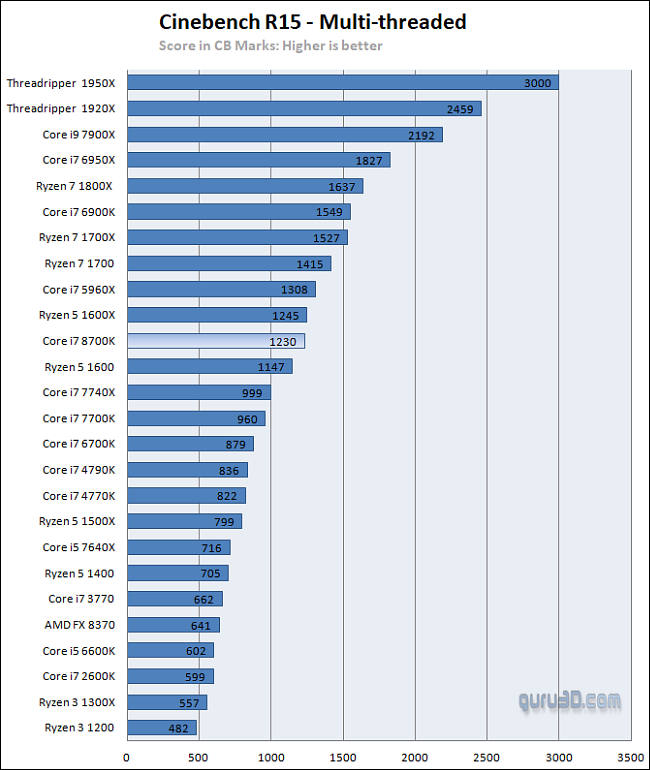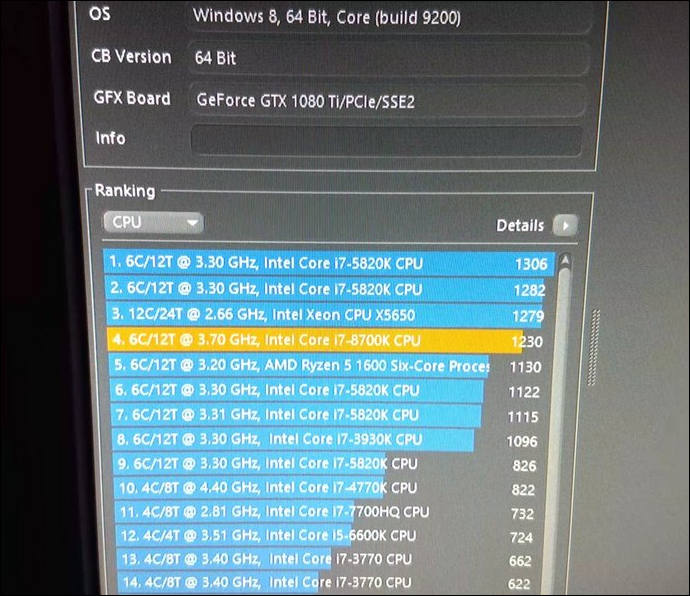
It allows to keep PV going, with more focus towards AI, but keeping be one of the few truly independent places.
-
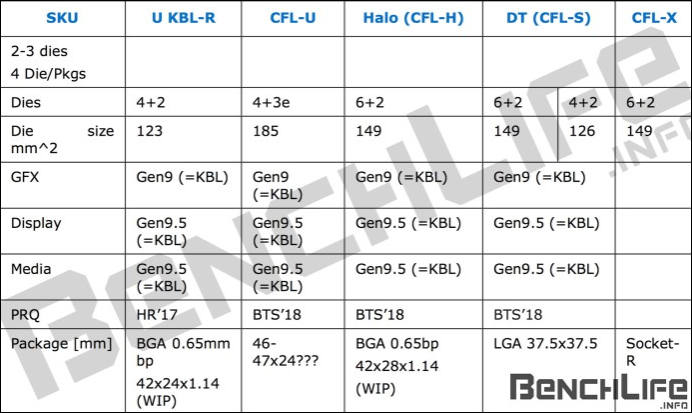
Both desktop and notebook performance lines will have 6 cores.
Yet, display and decoders support will be as Kaby Lake.
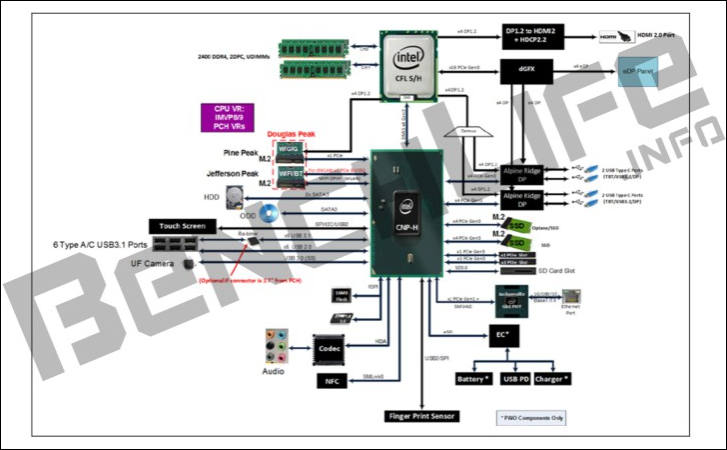
Also no progress with HDMI 2.0 support, again motherboard must have build in DP 1.2 to HDMI.
Check more at http://wccftech.com/intel-coffee-lake-2018-cpu-details/

 img2971.jpg692 x 413 - 54K
img2971.jpg692 x 413 - 54K
 img2972.jpg727 x 450 - 50K
img2972.jpg727 x 450 - 50K -
BF Sales
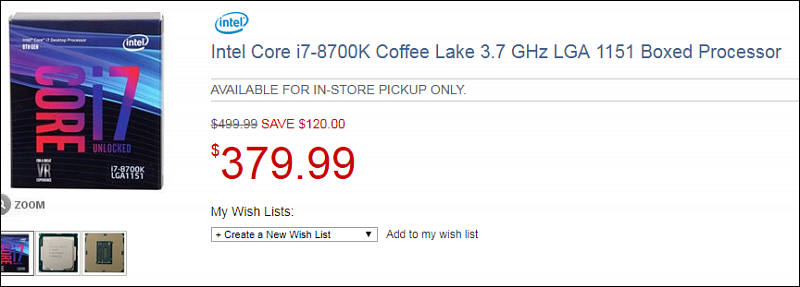
http://www.microcenter.com/product/486088/Core_i7-8700K_Coffee_Lake_37_GHz_LGA_1151_Boxed_Processor

 sa715.jpg800 x 287 - 38K
sa715.jpg800 x 287 - 38K -
i5-8400
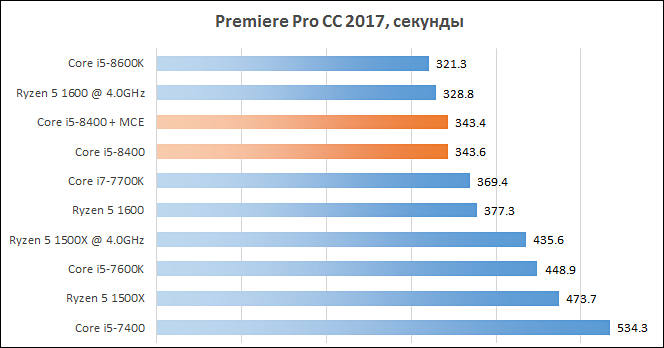
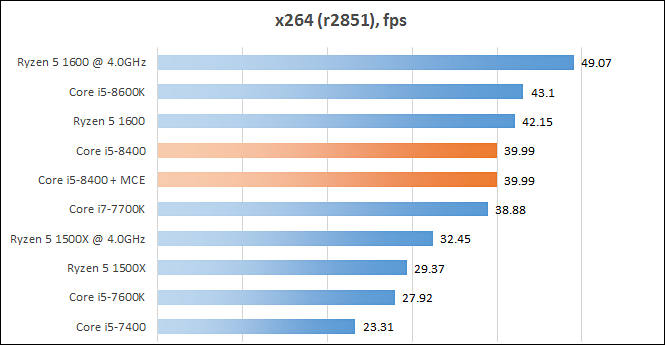
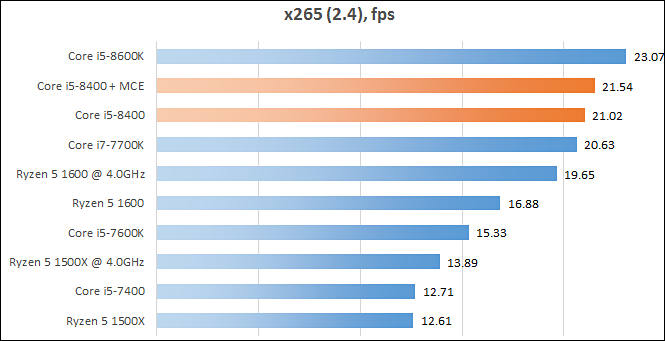

 sa646.jpg664 x 348 - 42K
sa646.jpg664 x 348 - 42K
 sa647.jpg665 x 345 - 39K
sa647.jpg665 x 345 - 39K
 sa648.jpg665 x 341 - 40K
sa648.jpg665 x 341 - 40K -
x264 encoding performance
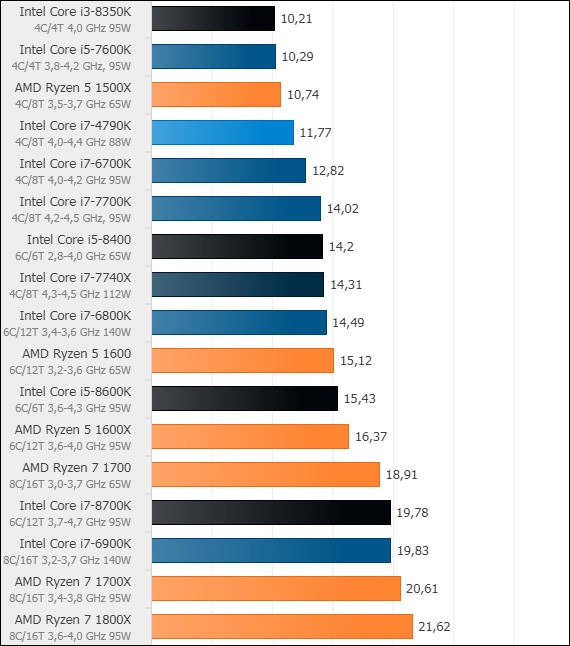
x265 encoding performance
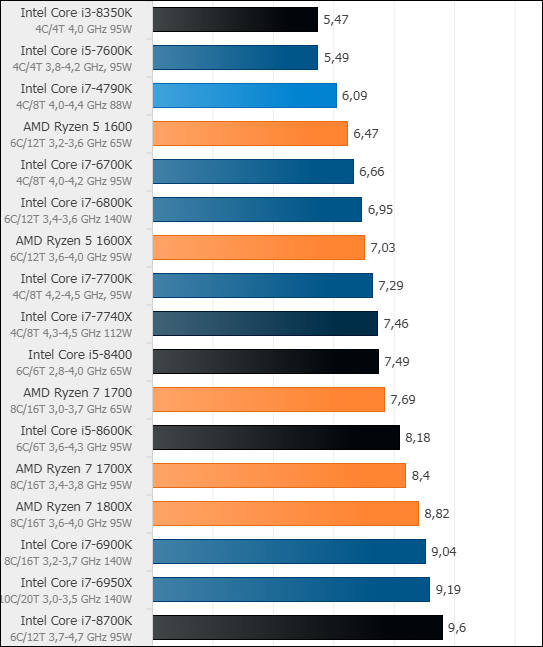

 sa616.jpg570 x 646 - 61K
sa616.jpg570 x 646 - 61K
 sa615.jpg543 x 647 - 64K
sa615.jpg543 x 647 - 64K -
Core i5-8600K review
Intel actually can't cope with cooling processor with Turbo mode.
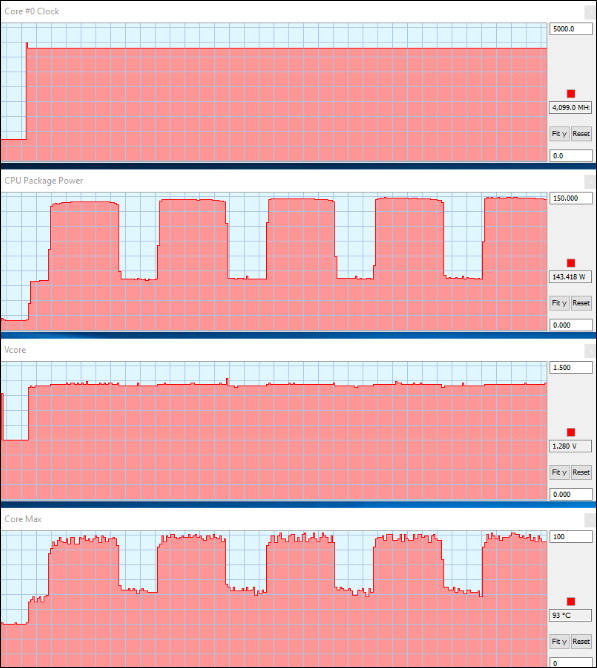
Intel actually ask Z370 board manufacturers to make Turbo mode more light (but they do not want to do it, as benchmarks will get up to 10% penalties)
Check below recommended mode (frequency and VCore drop)
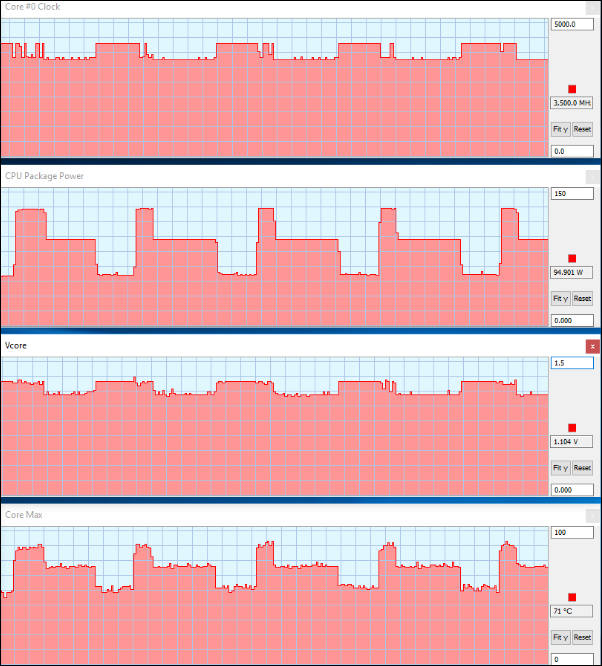
So almost all preliminary benchmarks had been artificially inflated 4-10%.
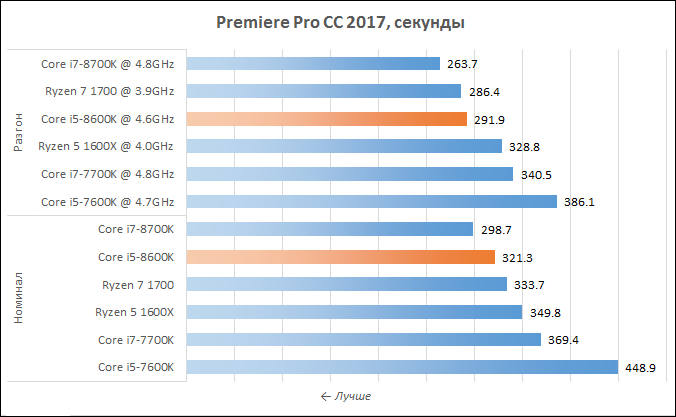
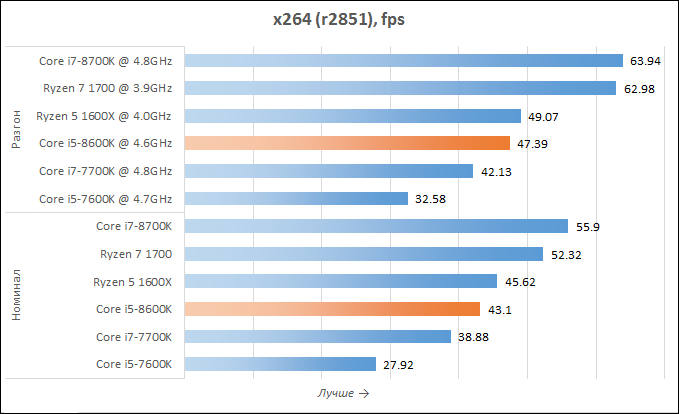
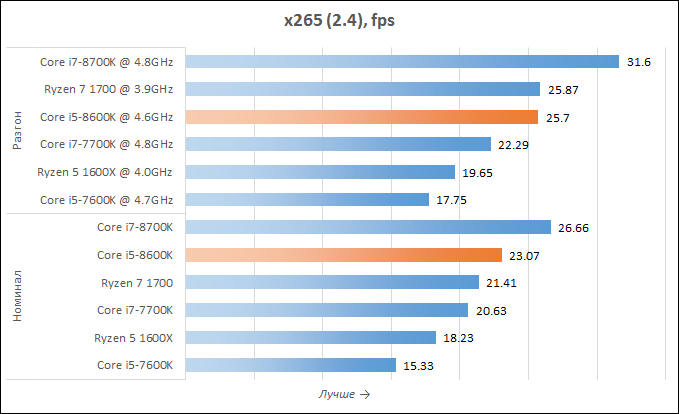

 sa418.jpg597 x 668 - 99K
sa418.jpg597 x 668 - 99K
 sa419.jpg602 x 666 - 99K
sa419.jpg602 x 666 - 99K
 sa420.jpg676 x 417 - 49K
sa420.jpg676 x 417 - 49K
 sa421.jpg679 x 414 - 48K
sa421.jpg679 x 414 - 48K
 sa422.jpg679 x 414 - 49K
sa422.jpg679 x 414 - 49K -
Overclocked results (note - they made replacement of thermal interface between chip and cover!)




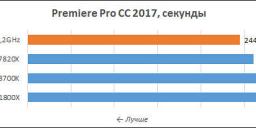
 s1415.jpg675 x 206 - 26K
s1415.jpg675 x 206 - 26K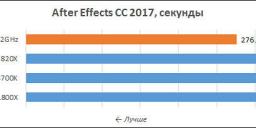
 s1416.jpg679 x 205 - 27K
s1416.jpg679 x 205 - 27K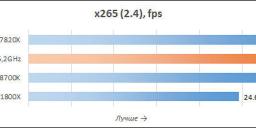
 s1417.jpg680 x 209 - 22K
s1417.jpg680 x 209 - 22K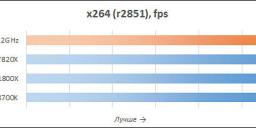
 s1418.jpg680 x 207 - 23K
s1418.jpg680 x 207 - 23K -
I think this comparison and whole talks are useless.
As they are for low bitrate modes and encoding of video games (it is fast jerky motion most of the time).
Power of hardware encoder is if you use good bitrates and normal videos (especially like your concerts that are mostly still). With normal bitrate difference with x264 will be really small.
-
The Intel renderer looks more blocky--not a big difference, maybe there is a way to optimize it.
https://obsproject.com/forum/threads/comparison-of-x264-nvenc-quicksync-vce.57358/ -
-
I'm trying out the Intel renderer but so far the results look more like preview material--still useful.
https://www.pugetsystems.com/labs/articles/Premiere-Pro-CC-2017-1-2-CPU-Performance-Core-i7-8700K-i5-8600K-i3-8350K-1047/ -
i5-8400 Benchmarks and Comparison
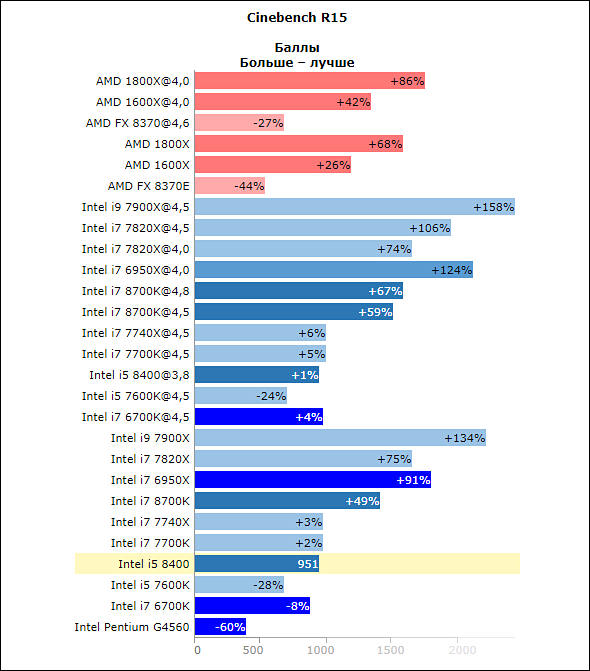

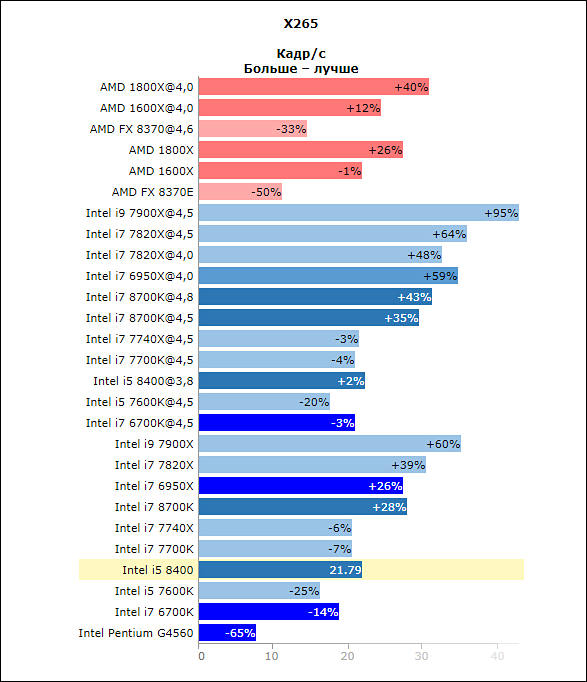

 s1368.jpg590 x 671 - 80K
s1368.jpg590 x 671 - 80K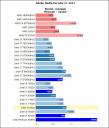
 s1369.jpg569 x 669 - 77K
s1369.jpg569 x 669 - 77K
 s1370.jpg587 x 682 - 82K
s1370.jpg587 x 682 - 82K -
Proper NLE with usual usage must offload all decoding and encoding to proper hardware (QuickSync or Nvidia GPUs). With all transitions and filters being done 90% on GPUs (10% is CPU due to transfers and such).
Almost all NLEs are designed for stone age still with huge inertia and old code. It is good reason why it is such, as developers qualification required for old approach is much lower.
-
You know, I never tried a non-hyperthreaded processor. I think I can use Quick Sync on Premiere if I also get the TMPGEnc plugin, I will try it out and see how the quality is.
That Intel chip looks juicy, but I would need a new MB as well. -
Nope.
If NLE is made properly even Core i5-8600K will be much faster due to QuickSync.
I mean here real NLE usage, not most benchmarks made of complex 3D transitions, CPU only filters and such.
-
At $600 the 7820 looks like a pretty good chip. The mainboard won't be cheap, but live playback and export times are excellent.
-
More benchmarks
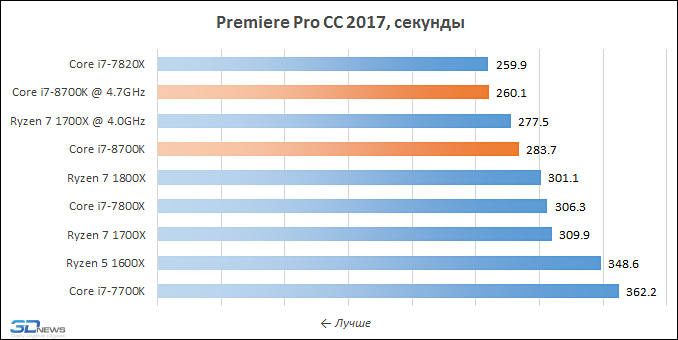
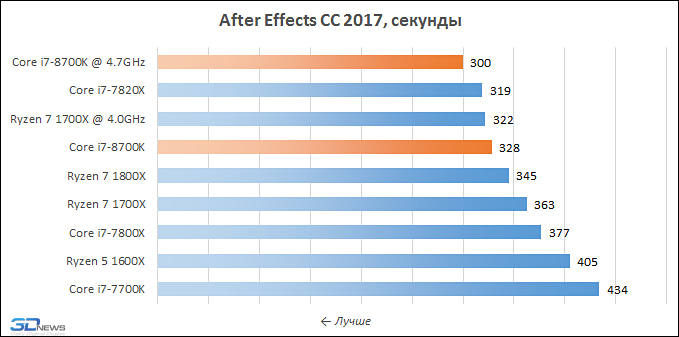
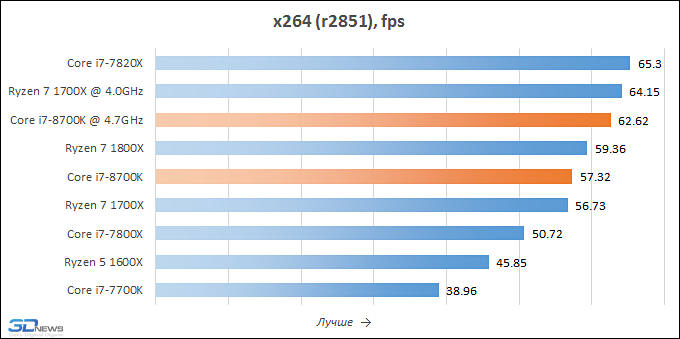
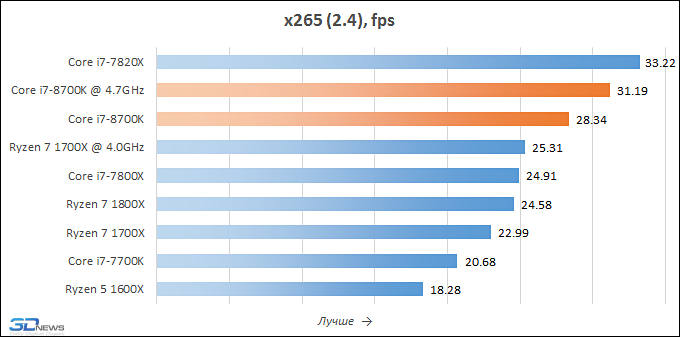

 s1261.jpg678 x 340 - 43K
s1261.jpg678 x 340 - 43K
 s1262.jpg679 x 337 - 40K
s1262.jpg679 x 337 - 40K
 s1263.jpg680 x 339 - 42K
s1263.jpg680 x 339 - 42K
 s1264.jpg680 x 337 - 39K
s1264.jpg680 x 337 - 39K -
CPUs available now
- i3-8350K is 4 code unlocked CPU at $204 https://www.amazon.com/Intel-BX80684I38350K-Core-i3-8350K-Processor/dp/B0759FWJDK/
- i5-8600K is 6 core unlocked CPU at $258.00 https://www.amazon.com/Intel-BX80684I58600K-Core-i5-8600K-Processor/dp/B0759FKH8K/
-
I do not see new thing being mentioned for now.
NLE authors actually got mostly stuck with QuickSync, instead of allow users to make cheap upgrade by simple changing GPU and rely on Nvidia library.
-
Are there any significant differences in the media capabilities (Quick Sync) of Coffee Lake compared to Kaby Lake processors?
Kaby Lake already had support for 10-bit HEVC/VP9 decode, 10-bit HEVC encode and Rec. 2020, HDR as described here: https://www.anandtech.com/show/10610/intel-announces-7th-gen-kaby-lake-14nm-plus-six-notebook-skus-desktop-coming-in-january/3
So, it's not clear that Coffee Lake actually has anything new in this area.
-
PR
SANTA CLARA, Calif., Sept. 24, 2017 – Intel today announced that its new family of 8th Gen Intel Core desktop processors will be available for purchase beginning Oct. 5, 2017. The new desktop processor family is built for gamers, content creators and overclockers who require premium performance. Ranging from Intel Core i3 to Intel Core i7, these processors deliver premium performance for what comes next, opening the door for a new level of faster, easier and more immersive experiences.
This new family introduces the first-ever 6-core Intel Core i5 desktop processor and first-ever 4-core Intel Core i3 desktop processor. The family offers a wide range of performance options for consumers with unlocked1 “K” processors that deliver maximum tuning flexibility at each brand level and up to 40 platform PCIe 3.0 lanes for system expandability on graphics, storage and I/O. These processors are supported with new Intel Z370 chipset-based motherboards.
The top of the product stack – the Intel Core i7-8700K – is Intel’s best gaming desktop processor ever.2 It is capable of 4.7 GHz maximum single-core turbo frequency, the highest frequency ever from Intel thanks to Intel® Turbo Boost Technology 2.0, making it a performance powerhouse for both single and multi-threaded applications.
“We are laser-focused on giving the enthusiast community the ultimate desktop experience, from chart-topping performance to a platform that can flex with their needs,” said Anand Srivatsa, general manager of the Desktop Platform Group at Intel. “Our 8th Gen Intel Core desktop processors deliver tremendous improvements across the board and – for gamers, in particular– offer an unbeatable experience.”
Powerful, Fluid and Vivid Gaming
Gamers will revel in the powerful and fluid experience of gaming. Compared with 7th Gen Intel Core, gamers gain up to 25 percent more frames per second3 on popular and demanding games like Gears of War* 4. As gaming continues to expand to include a social audience while playing, performance while mega-tasking is critical so game + stream + record is now up to 2 times faster5 compared with a 3-year-old machine.
Advanced Content Creation
Save time and create more. The 8th Gen Intel Core desktop processor family positions Intel as the choice for speed, accuracy, power, format compatibility and high-quality graphics creation and consumption. Edit 4K 360-degree videos with ease – up to 32 percent faster compared with the previous generation – plus, edit content up to 65 percent faster compared with a 3-year-old PC.
Better Overclocking
Performance matters with overclocking. The 8th Gen Intel Core unlocked1 “K” processors will overclock to higher levels than prior generations. Intel has added new features to enhance the experience, including per core overclocking, max memory ratio up to 8,400 MT/s, real-time memory latency control, extended PLL trim controls, enhanced package power delivery, and updated Intel® Extreme Tuning Utility and Intel® Extreme Memory Profile.
Enhanced Platform
For the platform, the new Intel Z370 chipset provides improved power delivery needed for the new 6-core processors to reach their maximum performance as well as enhanced package power delivery for overclocking and memory routing support. More than 50 new motherboard and system designs will be available from a variety of leading providers.
Launch games and load media projects faster. Add Intel® Optane™ memory to desktop computer with an 8th Gen Intel Core processor to gain additional accelerated system responsiveness, up to 2.1 times faster7 compared with a 5-year-old desktop with HDD alone.
8th Gen Intel Core desktop processors will be available beginning Oct. 5, 2017.
Howdy, Stranger!
It looks like you're new here. If you want to get involved, click one of these buttons!
Categories
- Topics List23,911
- Blog5,718
- General and News1,330
- Hacks and Patches1,148
- ↳ Top Settings33
- ↳ Beginners254
- ↳ Archives402
- ↳ Hacks News and Development56
- Cameras2,342
- ↳ Panasonic984
- ↳ Canon118
- ↳ Sony154
- ↳ Nikon95
- ↳ Pentax and Samsung70
- ↳ Olympus and Fujifilm98
- ↳ Compacts and Camcorders295
- ↳ Smartphones for video96
- ↳ Pro Video Cameras191
- ↳ BlackMagic and other raw cameras116
- Skill1,959
- ↳ Business and distribution66
- ↳ Preparation, scripts and legal38
- ↳ Art149
- ↳ Import, Convert, Exporting291
- ↳ Editors190
- ↳ Effects and stunts115
- ↳ Color grading197
- ↳ Sound and Music280
- ↳ Lighting96
- ↳ Software and storage tips266
- Gear5,407
- ↳ Filters, Adapters, Matte boxes344
- ↳ Lenses1,577
- ↳ Follow focus and gears93
- ↳ Sound496
- ↳ Lighting gear313
- ↳ Camera movement230
- ↳ Gimbals and copters302
- ↳ Rigs and related stuff271
- ↳ Power solutions83
- ↳ Monitors and viewfinders339
- ↳ Tripods and fluid heads139
- ↳ Storage286
- ↳ Computers and studio gear559
- ↳ VR and 3D248
- Showcase1,859
- Marketplace2,834
- Offtopic1,314



